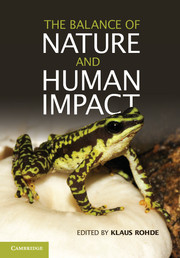Book contents
- Frontmatter
- Contents
- Foreword
- List of contributors
- Acknowledgments
- Introduction
- Part I Nonequilibrium and Equilibrium in Populations and Metapopulations
- Part II Nonequilibrium and Equilibrium in Communities
- Part III Equilibrium and Nonequilibrium on Geographical Scales
- Part IV Latitudinal Gradients
- Part V Effects Due to Invading Species, Habitat Loss and Climate Change
- Part VI Autecological Studies
- Part VII An Overall View
- Index
Foreword
Published online by Cambridge University Press: 05 March 2013
- Frontmatter
- Contents
- Foreword
- List of contributors
- Acknowledgments
- Introduction
- Part I Nonequilibrium and Equilibrium in Populations and Metapopulations
- Part II Nonequilibrium and Equilibrium in Communities
- Part III Equilibrium and Nonequilibrium on Geographical Scales
- Part IV Latitudinal Gradients
- Part V Effects Due to Invading Species, Habitat Loss and Climate Change
- Part VI Autecological Studies
- Part VII An Overall View
- Index
Summary
As a somewhat obsessive, but far from expert, sea kayaker, I attend to issues of stability a good deal. Kayakers distinguish two kinds. Primary or initial stability is a measure of how much a kayak rocks in the water when it is displaced from the level. Secondary or final stability is a measure of how readily a kayak capsizes. Beginners instinctively confuse the two. They are concerned that the rocking associated with the primary stability characteristics of a boat reflects its secondary stability, and in overreacting to the former they can overwhelm the latter, and get very wet as a consequence. With practice, one learns to improve the primary stability that is experienced under an increasingly wide variety of conditions of wind and wave, to reduce the likelihood of unintentionally exceeding a kayak’s secondary stability, and then to be able to use boats with inherently lower stability of both kinds. In a world in which the abundances and distributions of the majority of organisms are heavily influenced, and often continually buffeted, directly or indirectly by anthropogenic activities, we need to become the population management equivalent of more expert kayakers. This book provides one further step along that course.
Historically, ecologists have spent a lot of time debating whether populations have the equivalent of primary stability (i.e. whether they have their dynamics in some way bounded), how it varies intraspecifically and interspecifically, and what that might mean in turn for the structure and composition of assemblages and communities. Indeed, a plethora of measures have been developed to assess that stability, far in advance of what any typical group of kayakers might think of, but perhaps not dissimilar to the technicalities of boat and ship design. This book reveals that the debate is not over. However, in broad strokes, it is clear that (i) there is an enormous range of population behavior, and it is difficult to categorize in simple terms; (ii) that behavior can be very context specific, with regard to species, space, and time; and (iii) in consequence it can be difficult a priori to predict for any given case without knowing a good deal about those specifics.
- Type
- Chapter
- Information
- The Balance of Nature and Human Impact , pp. ix - xPublisher: Cambridge University PressPrint publication year: 2013



